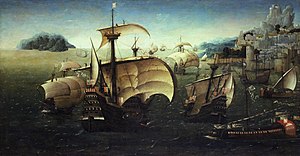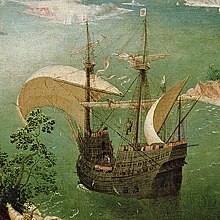Carrack
A carrack (Portuguese: nau; Spanish: nao; Catalan: carraca; Croatian: karaka) is a three- or four-masted ocean-going sailing ship that was developed in the 14th to 15th centuries in Europe, most notably in Portugal and Spain.
[1]English carrack was loaned in the late 14th century, via Old French caraque, from carraca, a term for a large, square-rigged sailing vessel used in Spanish, Italian and Middle Latin.
The origin of the term carraca is unclear, perhaps from Arabic qaraqir "merchant ship", itself of unknown origin (maybe from Latin carricare "to load a car" or Greek καρκαρίς "load of timber") or the Arabic القُرْقُورُ (al-qurqoor) and from thence to the Greek κέρκουρος (kerkouros) meaning approximately "lighter" (barge) literally, "shorn tail", a possible reference to the ship's flat stern).
[3] By the Late Middle Ages, the cog and cog-like square-rigged vessels equipped with a rudder at the stern, were widely used along the coasts of Europe, from the Mediterranean, to the Baltic.
As the Portuguese and Spaniards gradually extended their trade ever further south along Africa's Atlantic coast and islands during the 15th century, they needed larger, more durable and more advanced sailing ships for their long oceanic ventures.
Gradually, they developed their own models of oceanic carracks from a fusion and modification of aspects of the ship types they knew operating in both the Atlantic and Mediterranean, generalizing their use in the end of the century for inter-oceanic travel with a more advanced form of sail rigging that allowed much improved sailing characteristics in the heavy winds and waves of the Atlantic Ocean and a hull shape and size that permitted larger cargoes.
The Portuguese carracks were usually very large ships for their time, often over 1000 tons displacement,[4] and having the future naus of the India run and of the China and Japan trade, also other new types of design.
Starting in 1498, Portugal initiated for the first time direct and regular exchanges between Europe and India—and the rest of Asia thereafter—through the Cape Route, a voyage that required the use of more substantial vessels, such as carracks, due to its unprecedented duration, about six months.
[5]: 329–330 The harraqa (Saracen: karaque) was a type of ship used to hurl explosives or inflammable materials (firebomb in earthenware pots, naphtha, fire arrows).







